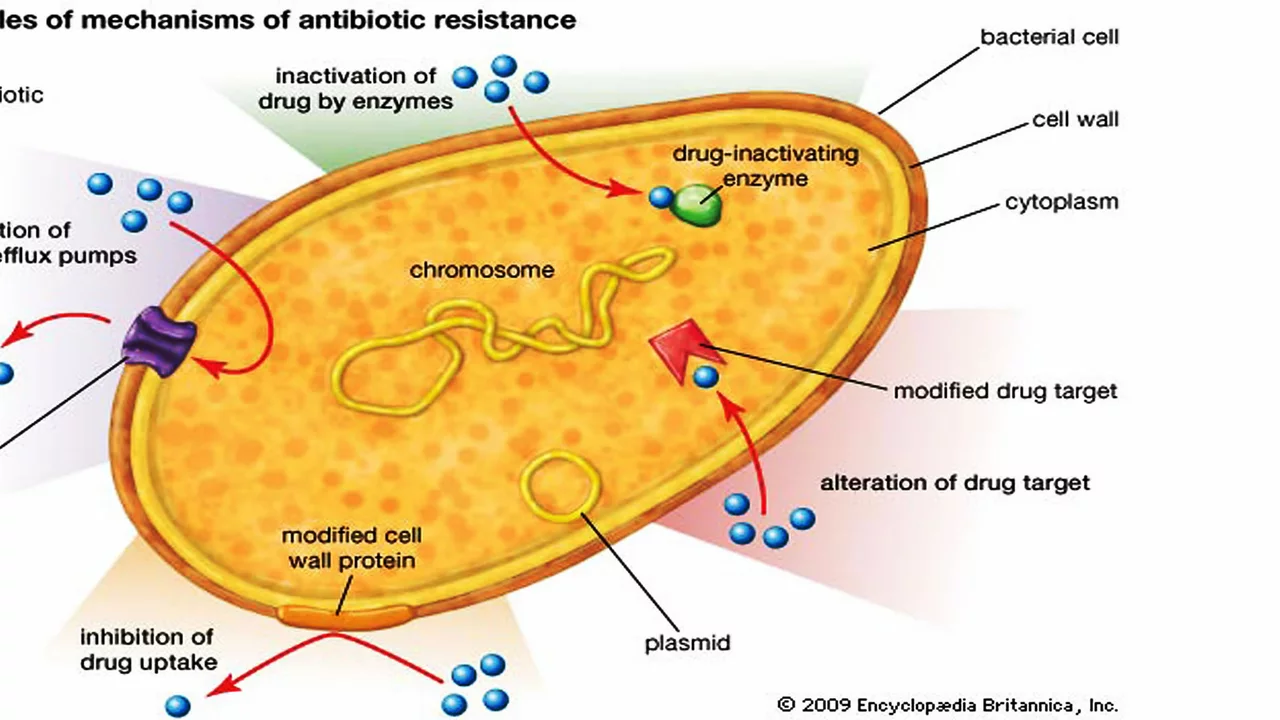
Understanding Bacterial Infections
Bacterial infections can be a serious health concern, causing a variety of symptoms and complications if left untreated. As a blogger and someone who is passionate about health, I have spent time researching and understanding these infections. Bacteria are microscopic, single-celled organisms that live in every environment in the world, including within our own bodies. While many bacteria are beneficial to our health, some can cause infections, which can range from mild to severe in intensity.
Introduction to Secnidazole
Secnidazole is an antibiotic, a medication specifically designed to treat bacterial infections. It belongs to a class of drugs known as nitroimidazoles. This medication works by stopping the growth of bacteria and protozoa. However, it's important to note that secnidazole will not work for viral infections such as common cold or flu. Inappropriate use or overuse of any antibiotic can lead to its decreased effectiveness.
Secnidazole in Action: How it Works
Secnidazole works by interfering with bacterial and protozoal DNA. The drug damages the DNA and prevents the bacteria and protozoa from forming new DNA. This results in the death of the organisms, which clears up the infection. The wonderful thing about secnidazole is that it's a single-dose treatment, which means you only need to take it once, unlike other antibiotics that require a course of several days or weeks.
Treating Bacterial Vaginosis with Secnidazole
Secnidazole is particularly effective in treating bacterial vaginosis, a common infection in women. Bacterial vaginosis occurs when the normal balance of bacteria in the vagina is disrupted, leading to an overgrowth of certain bacteria. Symptoms may include vaginal discharge, odor, itching, or burning. Secnidazole is a convenient and effective treatment option because it is taken as a single dose, making it easier to complete the treatment.
Secnidazole for Giardiasis and Amoebiasis
Secnidazole is also used in the treatment of parasitic infections such as giardiasis and amoebiasis. Giardiasis is an infection of the small intestine caused by a parasite, while amoebiasis is an infection caused by amoebae parasites, commonly affecting the intestines. Secnidazole works by killing the parasites, thereby effectively treating these infections.
Secnidazole Safety: Side Effects and Precautions
Like all medications, secnidazole can cause side effects, although not everyone who uses the drug will experience these. Common side effects can include nausea, a metallic taste in the mouth, and a dark or reddish-brown urine. Serious side effects are rare but can include a severe allergic reaction. If you experience any unusual or severe symptoms after taking secnidazole, it's important to seek medical attention right away.
Interactions of Secnidazole with Other Medications
Secnidazole can interact with other medications, which can affect how the drug works or increase your risk for serious side effects. It's important to keep a list of all the products you use, including prescription and non-prescription drugs and herbal products, and share it with your healthcare provider. You should not start, stop, or change the dosage of any medicines without your doctor's approval.
The Importance of Proper Use
Proper use of secnidazole is crucial for its effectiveness. This includes taking the medication exactly as prescribed by your healthcare provider, not taking more or less of it or taking it more often than prescribed. Even if you feel better, you should continue taking the medication for the full prescribed length of time, since stopping the medication too soon may allow bacteria to continue to grow, which may result in a return of the infection.
Secnidazole Resistance: A Growing Concern
Secnidazole, like other antibiotics, is facing the issue of bacterial resistance. This occurs when bacteria change in response to the use of antibiotics and become resistant, meaning the drugs no longer work against them. The misuse and overuse of antibiotics are major factors contributing to antibiotic resistance. Therefore, it's crucial to use secnidazole and other antibiotics responsibly.
The Verdict: Secnidazole's Role in Treating Bacterial Infections
From my research and understanding, secnidazole plays a critical role in treating bacterial and parasitic infections. It offers a convenient single-dose treatment option, making it easier for patients to comply with the treatment. However, like all antibiotics, it's crucial to use it responsibly to prevent the development and spread of antibiotic resistance.





mas aly
July 16, 2023 AT 05:55Secnidazole is primarily eliminated unchanged in the urine, so renal function can influence its clearance. Patients with impaired kidneys may need dose adjustment, although the single‑dose regimen often mitigates the need for complex monitoring. It’s also worth noting that the drug’s half‑life allows the one‑time dosing to maintain therapeutic levels for several days.
Abhishek Vora
July 25, 2023 AT 18:18The emergence of nitroimidazole‑resistant strains is a documented phenomenon, especially in regions with high usage of metronidazole analogs. Consequently, clinicians should confirm susceptibility when treatment failure is suspected, lest we inadvertently perpetuate resistance.
maurice screti
August 4, 2023 AT 06:40In the grand tapestry of antimicrobial pharmacology, secnidazole occupies a niche that is both commendably efficient and intellectually intriguing.
Its pharmacokinetic profile, characterized by rapid absorption and a prolonged plasma half‑life, circumvents the conventional necessity for multi‑day regimens.
Such a convenience, however, belies a deeper complexity that invites the discerning clinician to contemplate the broader implications of single‑dose therapy.
The molecular architecture of secnidazole, a nitroimidazole derivative, facilitates the generation of free radicals that selectively target anaerobic microorganisms.
This mode of action, while elegant, raises questions regarding collateral impact on the commensal flora, a topic that has been insufficiently explored in the literature.
Moreover, the drug’s capacity to traverse cellular membranes with ease underscores a pharmacodynamic potency that rivals its more venerable counterparts.
Yet, one must not be lulled into complacency by its apparent simplicity; the specter of antimicrobial stewardship looms large over any therapeutic decision.
The judicious deployment of secnidazole mandates a rigorous assessment of indication, ensuring that its application is reserved for infections where alternative agents are either contraindicated or suboptimal.
In practice, the single‑dose administration may engender greater patient adherence, thereby reducing the incidence of premature discontinuation that plagues lengthier courses.
Nevertheless, adherence is but one facet of the therapeutic equation; the emergence of resistant phenotypes remains an ever‑present threat demanding vigilant surveillance.
Empirical evidence suggests that resistance mechanisms, though presently rare, could be amplified by indiscriminate prescribing patterns.
Hence, the clinician’s role evolves from mere prescriber to guardian of microbial ecology, tasked with balancing individual patient benefit against population‑level risk.
In this context, secnidazole serves as a double‑edged sword-its efficacy is undeniable, yet its misuse could expedite the very resistance it seeks to circumvent.
The ethical imperative therefore compels us to integrate patient education, ensuring recipients comprehend the significance of completing the prescribed regimen despite the brevity of treatment.
Ultimately, the integration of secnidazole into therapeutic armamentaria should be predicated upon evidence‑based guidelines, robust diagnostic confirmation, and an unwavering commitment to antimicrobial prudence.
Abigail Adams
August 13, 2023 AT 19:03While the article laudably summarizes secnidazole’s indications, it glosses over the paucity of head‑to‑head trials versus metronidazole. Such omission may mislead clinicians into assuming parity without substantive evidence. A more rigorous appraisal of comparative efficacy would have strengthened the discourse.
Belle Koschier
August 23, 2023 AT 07:26It’s encouraging to see a focus on single‑dose convenience, as this can reduce barriers to treatment in underserved communities. Balancing accessibility with stewardship remains the key challenge.
Allison Song
September 1, 2023 AT 19:48One might reflect that the bacterial world, though microscopic, mirrors the macrocosm of competition and cooperation, reminding us of our own interdependence on microbial balance. Accordingly, any intervention should respect this delicate equilibrium.
Joseph Bowman
September 11, 2023 AT 08:11Some whisper that big pharma pushes secnidazole to replace older drugs for profit, but the clinical data still supports its targeted use. Keep an eye on prescribing trends, just in case.
Singh Bhinder
September 20, 2023 AT 20:34I’ve noticed that guidelines in different countries vary on whether secnidazole is first‑line for bacterial vaginosis. It would be useful to compare those recommendations side by side.
Kelly Diglio
September 30, 2023 AT 08:56Patients often report the metallic taste as an unpleasant side effect, yet this subjective experience is rarely addressed in standard counseling. Offering tips to mitigate the taste can improve overall satisfaction.
Carmelita Smith
October 9, 2023 AT 21:19Secnidazole’s single dose is a real game‑changer :)
Liam Davis
October 19, 2023 AT 09:42When considering drug‑drug interactions, note that secnidazole can inhibit CYP2C19, thereby elevating plasma levels of certain proton‑pump inhibitors, antihypertensives, and antiplatelet agents, which may necessitate dosage adjustments; furthermore, co‑administration with alcohol is contraindicated due to the risk of disulfiram‑like reactions, so patients should be advised accordingly :)
Arlene January
October 28, 2023 AT 22:04Hey folks, remember that finishing the dose is crucial-don’t skip out just because you feel better! A quick reminder can keep infections from bouncing back.
Kaitlyn Duran
November 7, 2023 AT 10:27I’ve heard some folks report rapid symptom relief when they used secnidazole for giardiasis, often noticing improvement within a day. The quick turnaround aligns with its pharmacodynamics.
Terri DeLuca-MacMahon
November 16, 2023 AT 22:50Wow, what a relief to have a one‑shot cure-no need for endless pills, no missed doses, just one‑time magic!!! 🎉😊 This kind of simplicity can truly empower patients and streamline care!!!
gary kennemer
November 26, 2023 AT 11:12Secnidazole’s dosing schedule simplifies compliance.
Payton Haynes
December 5, 2023 AT 23:35They say secnidazole is safe, but I hear it’s part of a bigger plan to keep us dependent on meds. Stay alert.
Earlene Kalman
December 15, 2023 AT 11:58This article is a fluff piece that ignores real risks. It reads like a sales pitch.
Brian Skehan
December 25, 2023 AT 00:20Another drug touted as miracle, yet the side‑effects get buried. People should read the fine print.